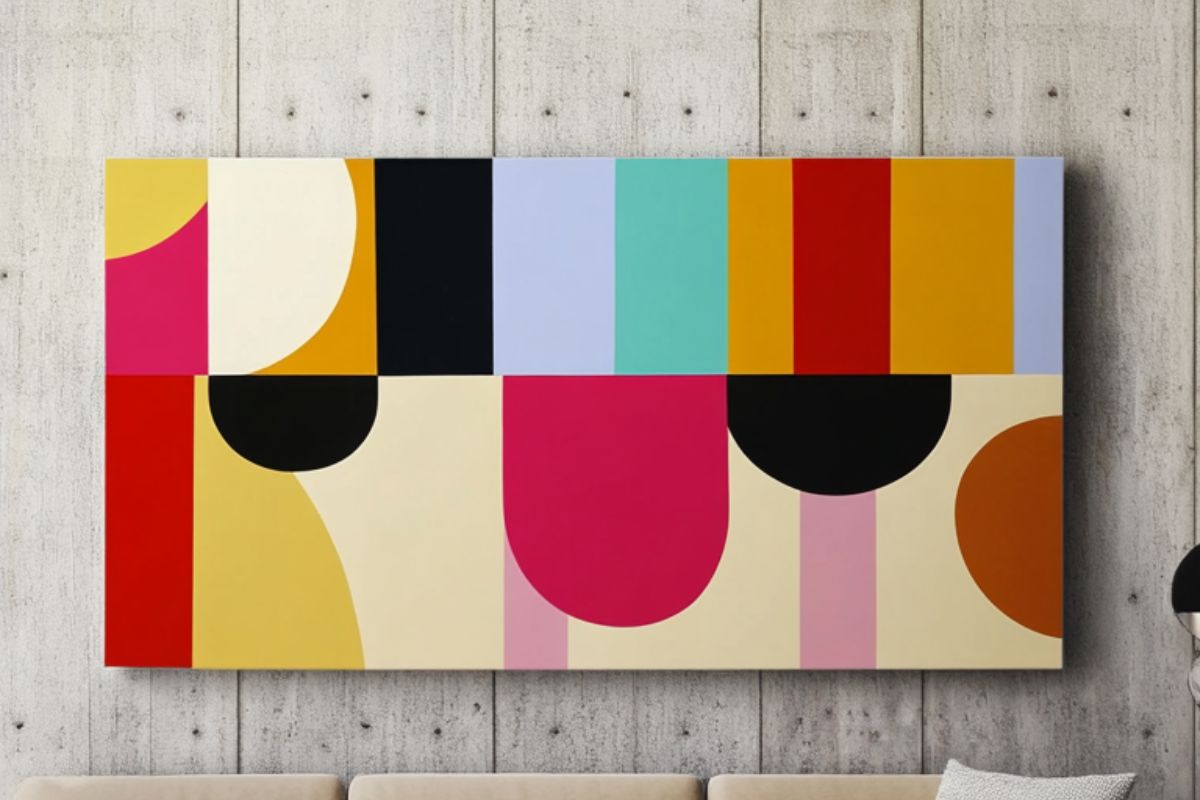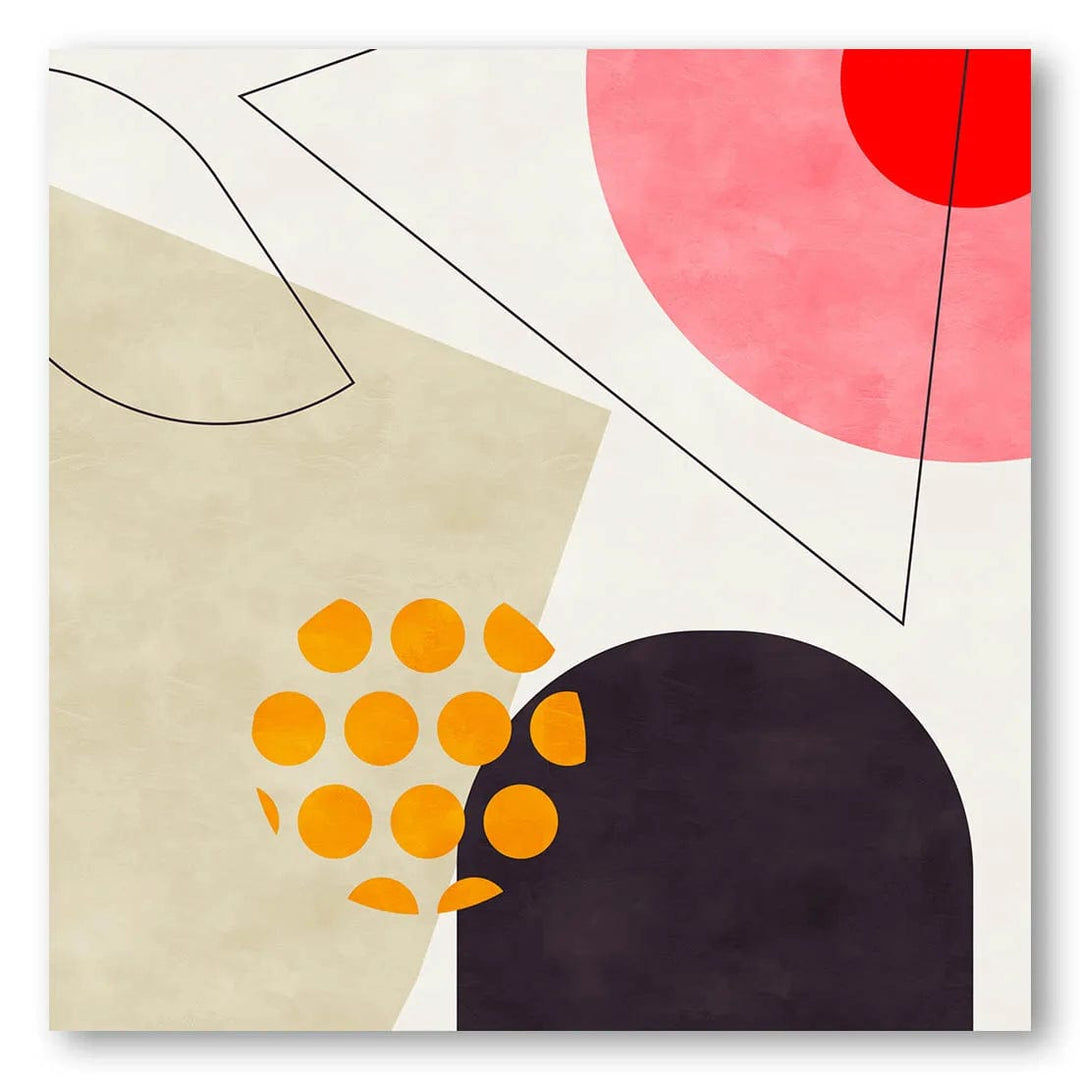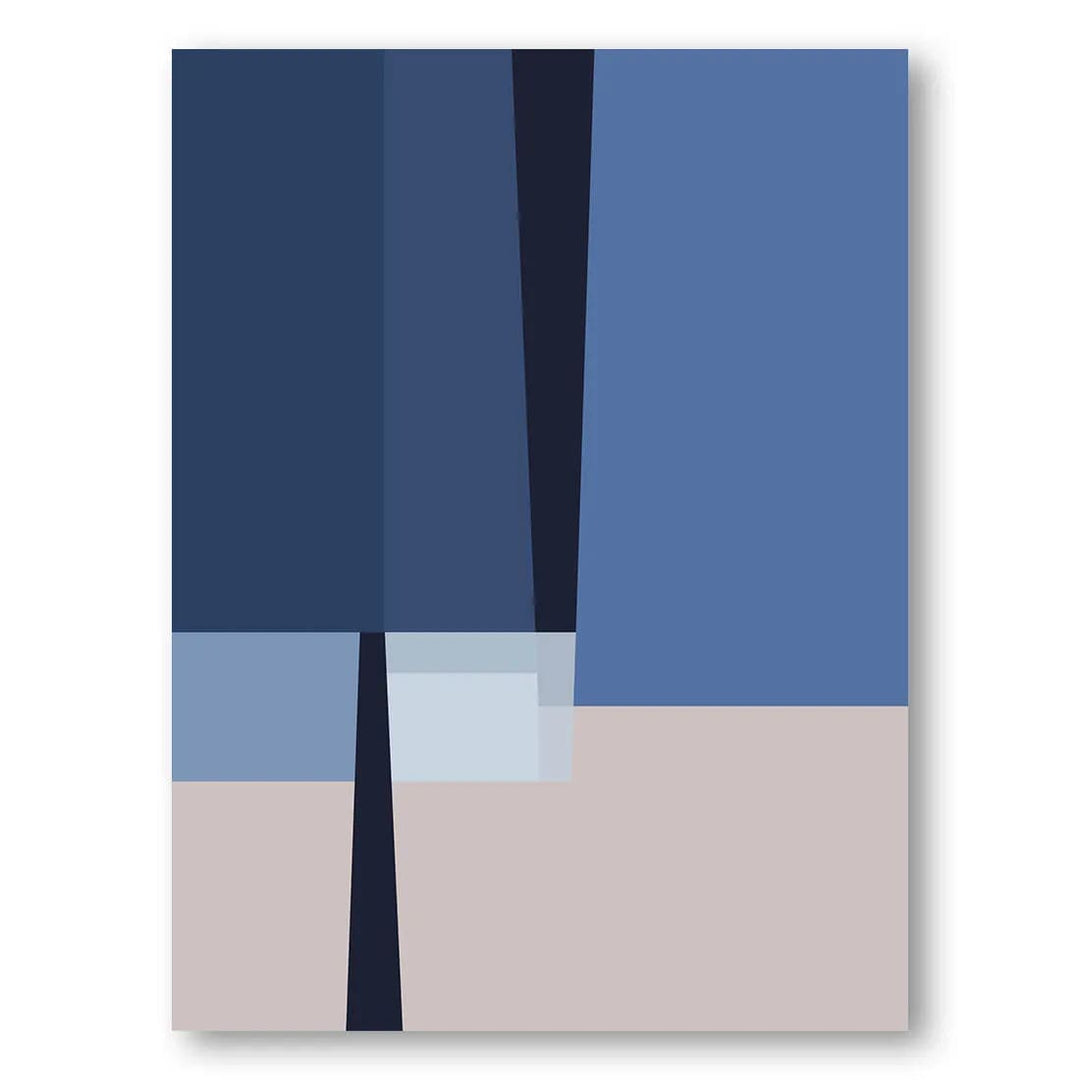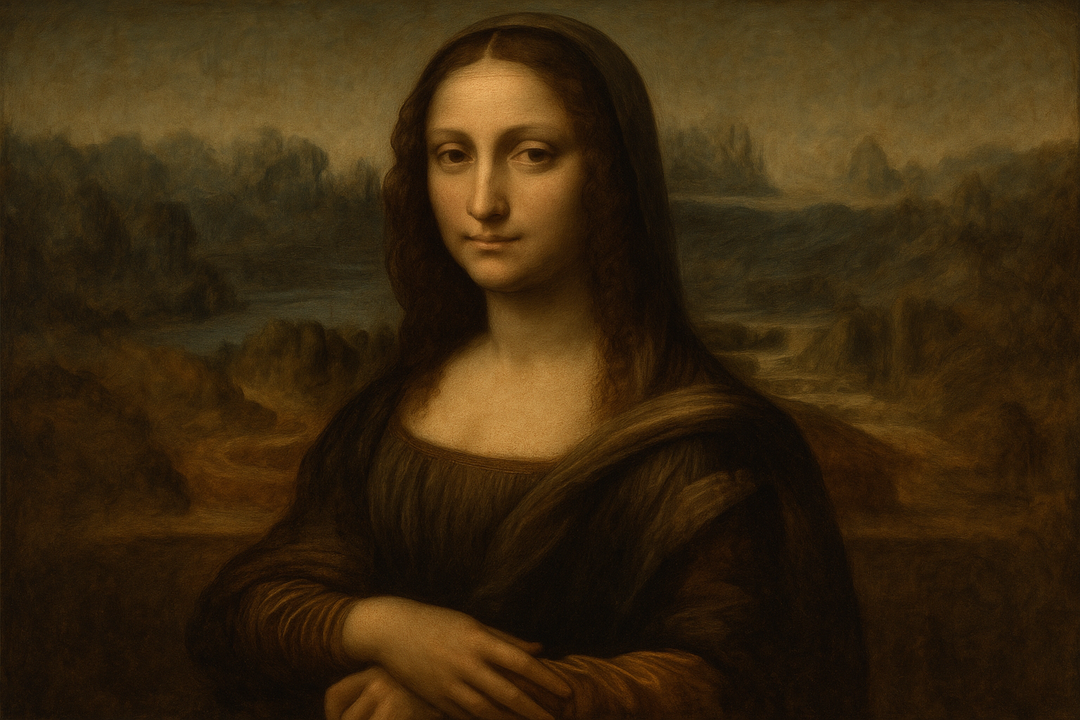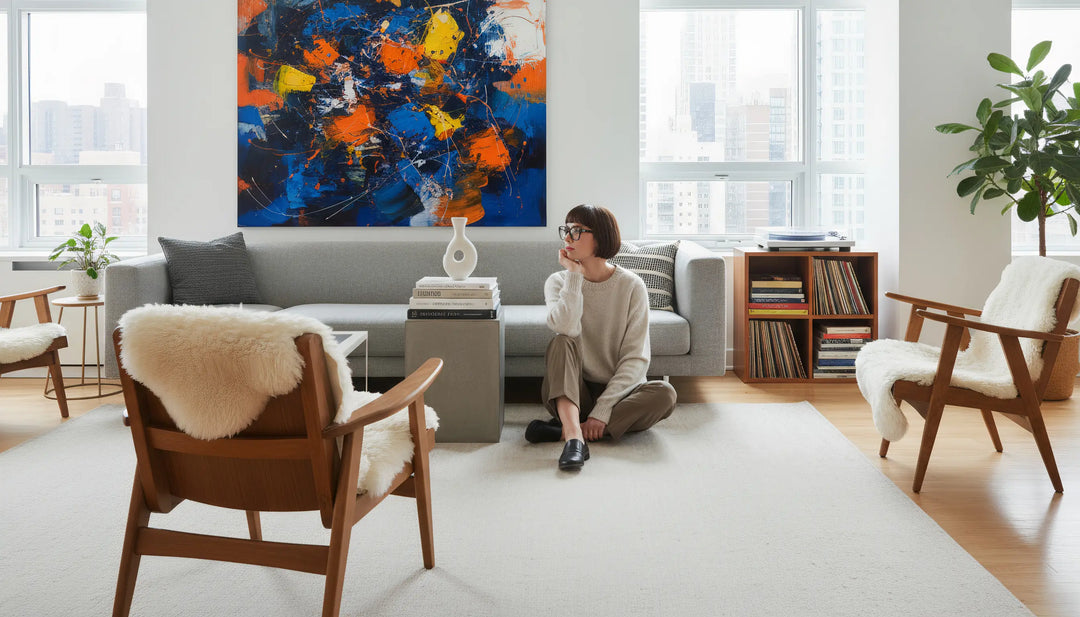| 🎨 Key Takeaways |
|---|
| • Hard Edge Abstract Art emerged in the 1950s as a reaction to Abstract Expressionism's emotional spontaneity • Characterized by razor-sharp lines, flat color planes, and geometric precision • Key artists include Ellsworth Kelly, Frank Stella, Kenneth Noland, and Carmen Herrera • Perfect for modern interiors seeking architectural harmony and bold visual impact • Represents a calculated approach to color relationships and spatial composition |
Transparency Note: This comprehensive guide is created by Stone & Gray's curatorial team to provide accurate art historical information about Hard Edge Abstract Art. While we feature our own museum-quality prints as examples, our primary goal is education. We believe informed art lovers make better decorating decisions regardless of where they purchase.
Understanding Hard Edge Abstract Art: Precision Meets Poetry
Hard Edge Abstract Art represents one of the most revolutionary developments in 20th-century painting—a movement where mathematical precision meets emotional resonance. Emerging in the 1950s, this style challenged the gestural spontaneity of Abstract Expressionism by introducing razor-sharp lines, flat color planes, and geometric clarity that would reshape how we understand abstract art.

Gallery walls featuring Hard Edge abstract art create striking focal points in contemporary interiors
🎨 Discover Your Perfect Hard Edge Art Style
Take our personalized quiz to find Hard Edge art that matches your aesthetic preferences and space requirements
The Revolutionary Birth of Hard Edge Art
The emergence of Hard Edge painting in the 1950s marked a radical departure from the emotional intensity of Abstract Expressionism. Artists like Ellsworth Kelly, Frank Stella, and Kenneth Noland sought to create art through calculated precision rather than gestural spontaneity. This movement represented a philosophical shift toward rationality, planning, and intellectual rigor in abstract art.

The evolution from Abstract Expressionism's emotional spontaneity to Hard Edge art's calculated precision
"Hard Edge painting represented a radical departure from the gestural spontaneity of Abstract Expressionism, offering instead a vision of art as rational, planned, and intellectually rigorous."
Techniques Behind Hard Edge Mastery
Hard Edge artists developed revolutionary techniques to achieve their signature precision. Understanding these methods reveals the sophisticated craftsmanship behind seemingly simple compositions:

🎨 Essential Hard Edge Techniques
- Precision Masking: Artists like Ellsworth Kelly used high-quality masking tape to create mathematically perfect edges
- Color Planning: Extensive preliminary sketches and color studies to plan relationships before painting
- Flat Application: Specially selected flat brushes and palette knives for consistent color saturation
- Surface Preparation: Meticulously prepared canvases to prevent paint bleeding and ensure crisp boundaries
- Layered Methodology: Building compositions through systematic layering of geometric elements
Hard Edge Art's Cultural Impact on Modern Design
The influence of Hard Edge painting extends far beyond gallery walls. This movement fundamentally changed how we approach color relationships in contemporary design, from architecture to digital interfaces. The principles established by Hard Edge pioneers now inform everything from smartphone app design to corporate branding.

The Psychology of Hard Edge Art in Interior Design
Recent studies from Stone & Gray's customer research reveal fascinating insights into how Hard Edge art affects our psychological response to spaces:
📊 Hard Edge Art Impact Research
- 78% of respondents report Hard Edge art makes their space feel "more organized and purposeful"
- 65% say bold geometric shapes help them feel more confident and focused
- Hard Edge art performs 23% better in productivity spaces versus soft abstract styles
- 87% prefer Hard Edge pieces in modern kitchens and home offices
Color Theory in Hard Edge Compositions
Hard Edge artists mastered color relationships through scientific precision. Unlike Impressionist color mixing, Hard Edge painting relies on pure color interactions and optical effects created by strategic placement of unmixed hues.
🔴 Primary Dominance
Bold reds, blues, and yellows create maximum visual impact through pure color relationships
🌡️ Temperature Contrast
Strategic warm/cool juxtapositions generate dynamic visual tension without blending
Exploring Hard Edge Masterpieces
To truly appreciate Hard Edge art, examine how master artists applied these principles. Our carefully curated collection showcases the evolution from pioneering works to contemporary interpretations:
![]()
These museum-quality reproductions demonstrate how Hard Edge principles create powerful visual statements through calculated restraint. Each piece exemplifies the movement's core philosophy: maximum impact through minimal, precisely planned elements.
Distinguished Hard Edge Artists and Their Contributions
The Hard Edge movement was shaped by visionary artists who revolutionized abstract painting through geometric precision:
🎨 Master Artists of Hard Edge Painting
Ellsworth Kelly (1923-2015)
Pioneer of color field Hard Edge painting, known for precise geometric shapes and bold color relationships. His works like "Red Blue Green" exemplify pure color interaction.
Frank Stella (1936-2024)
Famous for his stripe paintings and shaped canvases that challenged traditional rectangular formats while maintaining Hard Edge principles.
Kenneth Noland (1924-2010)
Master of target and chevron compositions, Noland explored how geometric forms could generate optical effects through precise color placement.
Carmen Herrera (1915-2022)
Cuban-American pioneer whose geometric abstractions predated many male contemporaries, featuring bold architectural compositions and masterful color relationships.
"Hard edge painting is characterized by areas of flat color with sharp, clean edges. It can be both abstract and geometric, representing a calculated approach to color and form."
Hard Edge Art in Contemporary South African Context
South Africa's relationship with Hard Edge abstraction reflects broader conversations about modernism and cultural identity. The Iziko South African National Gallery houses significant examples of geometric abstraction, while contemporary South African artists continue exploring how Hard Edge principles can express cultural narratives.
Artists like Kevin Atkinson pioneered Hard Edge techniques in South African art during the 1960s, creating geometric compositions that dialogue with international modernist movements while maintaining distinctly South African perspectives on color and form.
The 3 C's Framework: Choosing Hard Edge Art for Your Home
Stone & Gray's curatorial team has developed a systematic approach to selecting Hard Edge art that ensures perfect integration with your interior design:
🎨 COLOR
Consider your existing palette. Hard Edge art can either complement your current colors or provide strategic contrast. Primary colors energize, while monochromatic schemes create sophisticated calm.
⚡ CONTRAST
Hard Edge art excels at creating visual tension. Pair geometric precision with organic furniture, or use bold colors against neutral walls for maximum impact.
📐 COMPOSITION
Consider how geometric shapes relate to your room's architecture. Rectangular compositions complement modern windows, while circular forms soften angular spaces.
Contemporary Applications: Hard Edge Art in Modern Spaces
Today's interior designers increasingly turn to Hard Edge art for its ability to create sophisticated focal points without overwhelming spaces. The movement's principles align perfectly with contemporary minimalist aesthetics and open-plan living.
🏠 Hard Edge Art Placement Strategies
- Statement Walls: Large Hard Edge pieces create architectural drama in minimalist interiors
- Gallery Groupings: Multiple smaller works explore color and form relationships
- Corporate Environments: Hard Edge art conveys professionalism and creative thinking
- Transitional Spaces: Geometric precision guides movement through hallways and entryways
Hard Edge Art and Digital Age Aesthetics
The clean geometries of Hard Edge painting predicted our digital visual culture. Today's user interface design, smartphone aesthetics, and social media graphics all echo the flat color planes and precise boundaries pioneered by Hard Edge artists in the 1950s.
Collecting and Caring for Hard Edge Art Prints
Museum-quality Hard Edge reproductions require specific care to preserve their crisp boundaries and color saturation:
💡 Professional Care Tips
- UV Protection: Use museum-grade UV-filtering glass to prevent color fading
- Climate Control: Maintain stable temperature and humidity levels
- Proper Matting: Acid-free materials prevent chemical damage to edges
- Strategic Lighting: LED lighting avoids heat damage while highlighting geometric precision
Why Hard Edge Abstract Art Continues to Captivate
- Intellectual Sophistication: The calculated precision appeals to our appreciation for masterful craftsmanship
- Visual Clarity: Clean compositions provide respite from our increasingly complex visual environment
- Timeless Relevance: Geometric principles transcend stylistic trends, ensuring lasting appeal
- Emotional Resonance: Despite intellectual origins, Hard Edge art creates profound emotional responses through color relationships
- Architectural Harmony: The movement's geometric foundation perfectly complements contemporary interior design
Expanding Your Hard Edge Art Journey
For those drawn to Hard Edge art's precision and sophistication, explore related movements that share similar principles. Geometric Abstraction offers broader exploration of mathematical relationships in art, while De Stijl (Neoplasticism) provides historical context for geometric art's development.
Consider exploring how Hard Edge principles appear in Mid-Century Modern design or discover connections with Contemporary art movements that continue pushing geometric boundaries.
The Enduring Legacy of Hard Edge Precision
Hard Edge Abstract Art represents more than an artistic movement—it embodies a philosophy of calculated beauty, intellectual rigor, and emotional resonance through geometric precision. From its revolutionary emergence in 1950s America to its continued influence on contemporary design, Hard Edge painting demonstrates how disciplined artistic vision can create profound visual experiences.
Whether you're a seasoned collector or discovering abstract art for the first time, Hard Edge paintings offer sophisticated focal points that elevate any interior. The movement's emphasis on color relationships, geometric harmony, and precise craftsmanship ensures these works remain as relevant today as when they first challenged artistic conventions seven decades ago.
Ready to bring Hard Edge sophistication to your space? Explore Stone & Gray's curated collection of Hard Edge Abstract Art prints, featuring museum-quality reproductions that preserve the original precision and revolutionary spirit of this transformative artistic movement.

Nikki Sandeman
Art Lover & Décor Specialist | Founder
With a 15-year journey renovating homes and styling living spaces, Nikki specializes in helping readers integrate unique wall art and custom prints into modern interiors. Her expertise in Hard Edge art stems from extensive study of mid-century design movements and their continued relevance in contemporary spaces.




